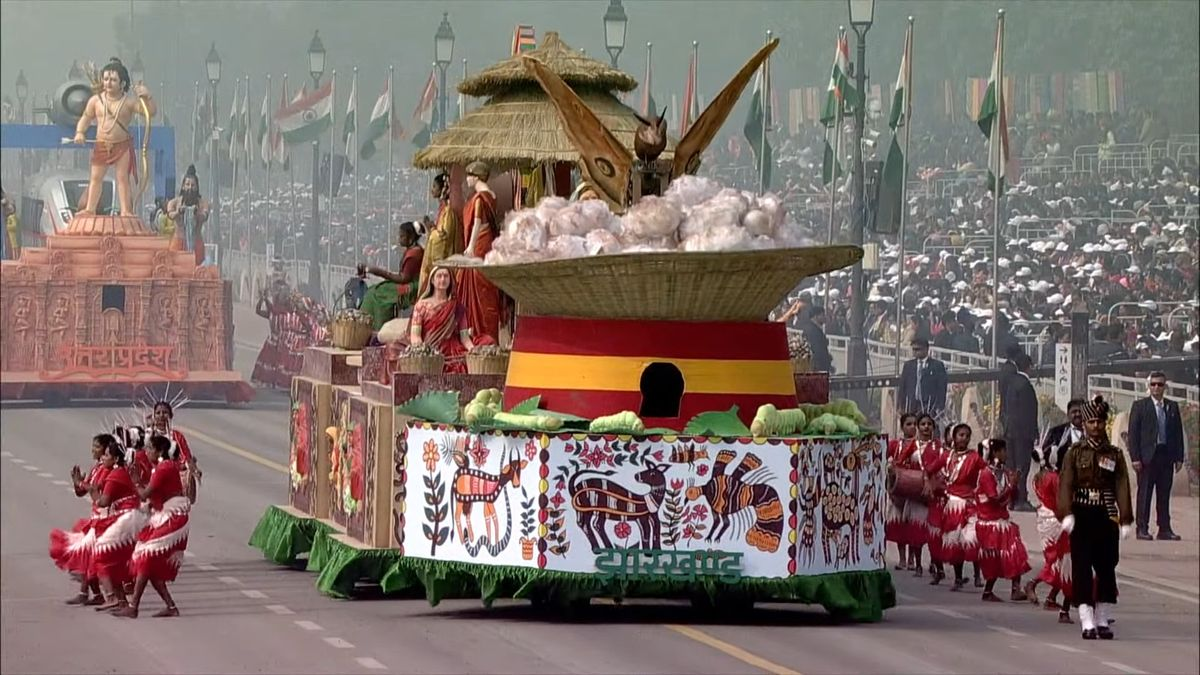Description

Copyright infringement not intended
Picture Courtesy: www.newsdrum.in
Context: Jharkhand's Republic Day tableau highlighted the traditional skill of tribal women in Tasar silk production, showcasing the process from rearing moths to global garment distribution.
Details
- The tableau depicted the entire lifecycle of Tasar silk, starting with the rearing of Tasar moths on Asan and Arjun trees. It then showcased the meticulous process of cocoon collection, degumming, yarn spinning, and finally, the weaving of intricate silk fabrics.
- The tableau highlighted the central role of tribal women in each stage of the production. Their expertise in rearing moths, extracting silk, and weaving mesmerizing patterns was prominently displayed, paying tribute to their generations-old traditions.
- The tableau didn't just focus on the traditional aspects. It also showcased the modern advancements in Tasar silk production, including the use of technology and design innovations. It hinted at the global reach of Jharkhand's Tasar silk, with glimpses of its presence in international markets.
.jpg)
Tasar Silk
- India is the second-largest producer of Tasar silk in the world, accounting for about 10% of global production.
- It is a wild silk variety produced by the larvae of the Antheraea mylitta silkworm, which feeds on various trees like Asan (Terminalia tomentosa) and Arjun (Terminalia arjuna).
- Tasar silk production is mainly concentrated in the eastern states of India, with Jharkhand, Chhattisgarh, Odisha, West Bengal, and Bihar being the major producers.
- The silkworms are reared in natural conditions on forest trees, and the cocoons are collected after the moths emerge.
- Ahimsa silk is a special type of Tasar silk produced by allowing the moths to emerge from the cocoons before degumming, ensuring no harm to the insects.
Cultivating the Wild Silkworms
- Unlike the domesticated mulberry-fed Bombyx mori worms, tasar silkworms are semi-domesticated, thriving on a variety of forest trees like Arjun, Sal, and Asan.
- Farmers collect eggs from moths and raise the larvae in controlled environments for the initial stages before releasing them onto the host trees.

Cocoon Collection and Sorting
- After around 25 days, the larvae spin cocoons, which are carefully collected from the trees.
- The cocoons are then sorted based on size, colour, and quality, with the plumpest and most uniform ones yielding the finest silk.
Degumming and Softening
- To extract the silk fibres, the cocoons undergo a process called degumming. Traditionally, they are boiled in water with soda ash, which dissolves the gum that binds the fibres together.
- Modern methods use enzymes or other chemicals for a more controlled and efficient degumming process.
Reeling the Silk Threads
- The degummed cocoons are then reeled, a delicate process where the continuous filament of silk is unwound and collected.
- Skilled artisans use specialized machines or traditional charkhas (spinning wheels) to gently draw out the silk fibres, forming thin threads.
Spinning and Weaving
- The reeled threads are then spun into yarn, and twisted together to create stronger strands.
- Weavers, using handlooms or power looms, meticulously interlace the yarn to create stunning fabrics with intricate patterns and textures.
Dyeing and Finishing
- Tasar silk naturally possesses a warm golden hue, but it can be dyed in a vibrant array of colours using natural or synthetic dyes.
- The final step involves finishing processes like scouring, bleaching, and softening to enhance the fabric's lustre, texture, and drape.

Conclusion
- The journey of tasar silk, from the verdant forests to the shimmering garments, is a captivating tale of nature's bounty and human craftsmanship. Each step, from the meticulous care of the silkworms to the intricate art of weaving, reflects a deep respect for tradition and a commitment to creating stunning textiles that are both beautiful and sustainable.
Must Read Articles:
TABLEAUX FOR THE REPUBLIC DAY: https://www.iasgyan.in/daily-current-affairs/tableaux-for-the-republic-day
Silk: https://www.iasgyan.in/daily-current-affairs/silk#:~:text=Silk%20is%20a%20natural%20fiber,insects%20secrete%20to%20make%20cocoons.
|
PRACTICE QUESTION
Q. The practice of "chawki rearing" in sericulture refers to:
A) Raising healthy silkworm eggs to ensure strong larvae
B) Splitting cocoons for easier extraction of silk fibres
C) Harvesting mulberry leaves at the optimal stage for silkworm feeding
D) Weaving intricate designs into silk fabric
Answer: A
Explanation:
Sericulture is the art and science of producing silk from silkworms. One of the most important aspects of sericulture is chawki rearing, which involves raising healthy silkworm eggs to ensure strong larvae. Chawki rearing requires careful attention to temperature, humidity, hygiene, and nutrition of the silkworms. The quality of chawki rearing determines the growth, survival, and cocoon production of the silkworms. Chawki rearing is different from splitting cocoons, which is the process of cutting open the cocoons to extract the silk fibres; harvesting mulberry leaves, which is the process of collecting the leaves that are the sole food source of the silkworms; and weaving silk fabric, which is the process of creating textiles from the silk fibres.
|









